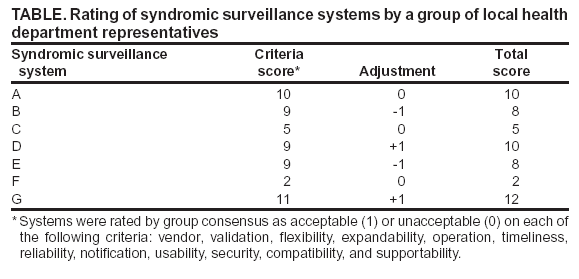 |
|
|
|
|
|
|
| ||||||||||
|
|
|
|
|
|
|
||||
| ||||||||||
|
|
|
|
|
Persons using assistive technology might not be able to fully access information in this file. For assistance, please send e-mail to: mmwrq@cdc.gov. Type 508 Accommodation and the title of the report in the subject line of e-mail. Practical Evaluation of Electronic Disease Surveillance Systems for Local Public HealthCynthia B. Yund,1 M.
Ottaway,1 D. Brannen2
Corresponding author: Cynthia Yund, 250 Howard Taft Rd., 2nd Fl., Cincinnati, OH 45219. Telephone: 513-946-7809; Fax: 513-946-7890; E-mail: cynthia.yund@hamilton-co.org. Abstract Introduction: Practical use of electronic disease surveillance systems is in the public health domain. Academia and the private sector have provided multiple surveillance options. The onus lies with public health to determine which system best supports the current infrastructure. Traditionally, public health has not had the capacity for such systems. Objectives: A process was established to evaluate multiple electronic surveillance products for a population of >1.6 million persons. The geographic area encompasses 16 local health jurisdictions within eight southwestern Ohio counties consisting of urban, suburban, and rural populations. Methods: Seven viable surveillance systems were identified through an Internet search. Members researched selected systems according to published criteria for evaluation of electronic disease surveillance systems, including vendor, validation, flexibility, expandability, operation, timeliness, reliability, notification, usability, security, compatibility, and supportability. Systems were rated by group consensus as acceptable (1) or unacceptable (0) on each of the criteria. A total score was assigned. Scores were adjusted (+1, 0, or --1) according to feasibility of local implementation on the basis of need for physical and human resources. Results: Total adjusted scores ranged from 2 to 12 (Table). The Real-Time Outbreak and Disease Surveillance system was identified as superior and most feasible for local implementation. Conclusions: Use of a group process to research the feasibility of using syndromic surveillance in local health jurisdictions increased the group's knowledge about the benefits of early warning indicators and facilitated discussion on viable systems. Table  Return to top.
Disclaimer All MMWR HTML versions of articles are electronic conversions from ASCII text into HTML. This conversion may have resulted in character translation or format errors in the HTML version. Users should not rely on this HTML document, but are referred to the electronic PDF version and/or the original MMWR paper copy for the official text, figures, and tables. An original paper copy of this issue can be obtained from the Superintendent of Documents, U.S. Government Printing Office (GPO), Washington, DC 20402-9371; telephone: (202) 512-1800. Contact GPO for current prices. **Questions or messages regarding errors in formatting should be addressed to mmwrq@cdc.gov.Page converted: 10/4/2004 |
|||||||||
This page last reviewed 10/4/2004
|